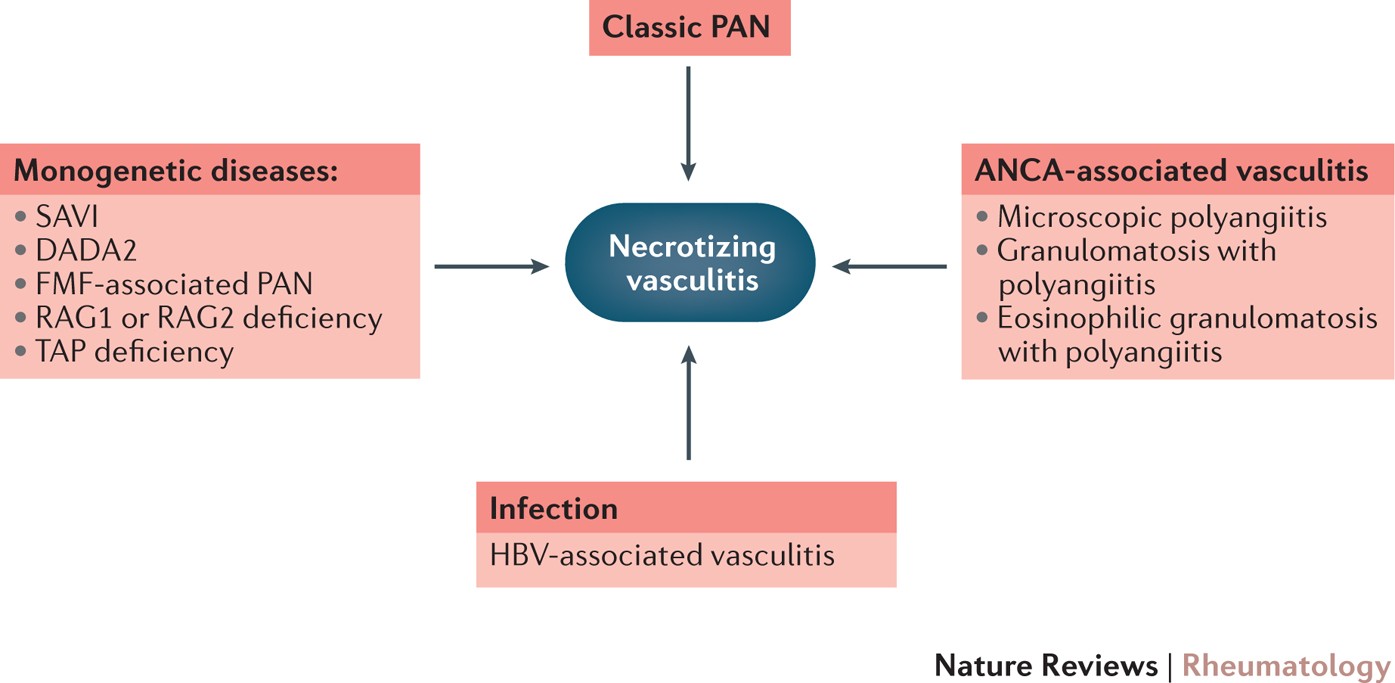Polyarteritis Nodosa (PAN)

Polyarteritis Nodosa (PAN): Overview, Symptoms, and Management
Polyarteritis nodosa (PAN) is a rare systemic vasculitis characterized by inflammation and necrosis of medium-sized arteries, leading to tissue ischemia and organ damage. Untreated PAN can result in life-threatening complications, but early intervention improves outcomes.
Causes and Risk Factors
- Autoimmune Dysregulation: Immune system mistakenly attacks arterial walls, causing inflammation and weakening vessel integrity13.
- Infections: Strongly linked to hepatitis B or C (especially in injection drug users)56.
- Other Triggers: Genetics, blood disorders, or unknown factors6.
- Risk Factors: Middle-aged adults (peak 40–50 years), hepatitis B/C infection, and drug use25.
Symptoms of PAN
PAN affects multiple organs, with symptoms varying by location:
| Organ System | Symptoms |
|---|---|
| General | Fever, fatigue, weight loss, muscle/joint pain127. |
| Skin | Rashes, subcutaneous nodules, livedo reticularis, necrotic ulcers47. |
| Nervous System | Peripheral neuropathy (numbness, weakness), mononeuritis multiplex47. |
| Kidneys | Hypertension, proteinuria, renal failure46. |
| Gastrointestinal | Abdominal pain, bowel ischemia/perforation, blood in stool14. |
| Cardiovascular | Chest pain, heart failure, myocardial infarction46. |
Note: PAN typically spares the lungs46.
Diagnosis
Diagnosis involves clinical evaluation and imaging:
- Biopsy: Shows necrotizing inflammation in arteries (definitive test)26.
- Angiography: Reveals aneurysms (“rosary sign”) and arterial narrowing46.
- Blood Tests: Elevated ESR/CRP, hepatitis B/C screening15.
- Exclusion: Rule out mimics (e.g., granulomatosis with polyangiitis)2.
Treatment
- Immunosuppressants:
- Corticosteroids (prednisone) for acute inflammation26.
- Cyclophosphamide or azathioprine for severe cases26.
- Antiviral Therapy: For hepatitis B/C-associated PAN5.
- Supportive Care: Blood pressure control, pain management6.
Complications
- Organ Failure: Renal insufficiency, bowel perforation, stroke47.
- Aneurysm Rupture: Risk of hemorrhage6.
- Chronic Neuropathy: Persistent numbness or weakness4.
Prognosis
- Untreated: 5-year survival rate 13%4.
- Treated: 5-year survival improves to 80% with early immunosuppression46.
Conclusion
Polyarteritis nodosa (PAN) is a medical emergency requiring prompt diagnosis and aggressive therapy. Early treatment with immunosuppressants and antiviral agents (if hepatitis-linked) significantly reduces morbidity and mortality.
Consult with Our Team of Experts Now!
At DrStemCellsThailand (DRSCT)‘s Anti-Aging and Regenerative Medicine Center of Thailand, we emphasize comprehensive evaluations and personalized treatment plans of Cellular Therapy and Stem Cells for managing various health conditions. If you have questions about Polyarteritis Nodosa (PN) or would like more information on our services, consult with our experts today!















